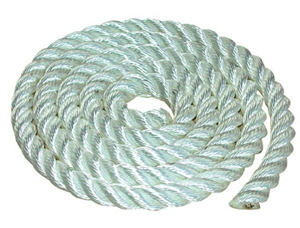ROPE, nylon, Ø 1mm, braided, per metre
Valid Article
ROPE
Definition
Rope available in different materials and different diameters for many uses.
Specifications
Continuous fibre rope, twisted or braided.
Available in 3 materials:
- natural fibres (NF)
- polypropylene (PP)
- polyamide/nylon (NYL)
A twisted rope will be stronger than a braided rope of the same material.
Nylon resists UV better than polypropylene.
NF | PP | NYL | |
Wear resistance | + | + | ++++ |
Elasticity | + | ++ | ++++ |
Tensile strength | - | + | ++ |
Price | low | medium | high |
Instructions for use
The choice of rope will depend on the intended use. 3 types of use can be distinguished:
Light use
- Function: fixing light items, tying up packages, etc.
- Choice: depending on local availability and price. Any material would be suitable: sisal, Manila hemp, other natural fibres etc.
General use
- Function: pegging down a small tent; constructing a shelter made of plastic sheeting; fencing; tying down a load on a vehicle etc.
- Choice: polypropylene, diameter 5 to 14 mm.
Heavy-duty or long-term use
- Function: pegging down a large tent, towing a vehicle, securing a radio mast etc.
- Choice: polypropylene, diameter 10 mm and above, or nylon, diameter 6 mm (20 mm for towing a vehicle). Nylon is preferable for long-term use.
To avoid a nylon rope unravelling, you are recommended to melt the ends.
For family shelters made of plastic sheeting, the larger the diameter of the rope used as a ridge, the less it will damage the sheeting.


![[KMEDMEBO04A] (module VHF isolation) LOGISTIC AND SANITATION](/web/image/product.template/571742/image_256/%5BKMEDMEBO04A%5D%20%28module%20VHF%20isolation%29%20LOGISTIC%20AND%20SANITATION?unique=e000fd4)
![[KADMKLIF02-] KIT, SURVIVAL, explo/evacuation, 2 persons/3 days](/web/image/product.template/554253/image_256/%5BKADMKLIF02-%5D%20KIT%2C%20SURVIVAL%2C%20explo-evacuation%2C%202%20persons-3%20days?unique=cb02f9a)
![[KADMMLIFC08] (module team life, 8 pers.) COOKING EQUIPMENT](/web/image/product.template/554192/image_256/%5BKADMMLIFC08%5D%20%28module%20team%20life%2C%208%20pers.%29%20COOKING%20EQUIPMENT?unique=0b64e01)
![[KCAMMINS01C] MODULE, CAMP INSTALLATION + BOUNDARY](/web/image/product.template/554148/image_256/%5BKCAMMINS01C%5D%20MODULE%2C%20CAMP%20INSTALLATION%20%2B%20BOUNDARY?unique=e7551b0)
![[KPROKTOO4--] KIT TOOLS, carpentry](/web/image/product.template/550632/image_256/%5BKPROKTOO4--%5D%20KIT%20TOOLS%2C%20carpentry?unique=1ee8071)